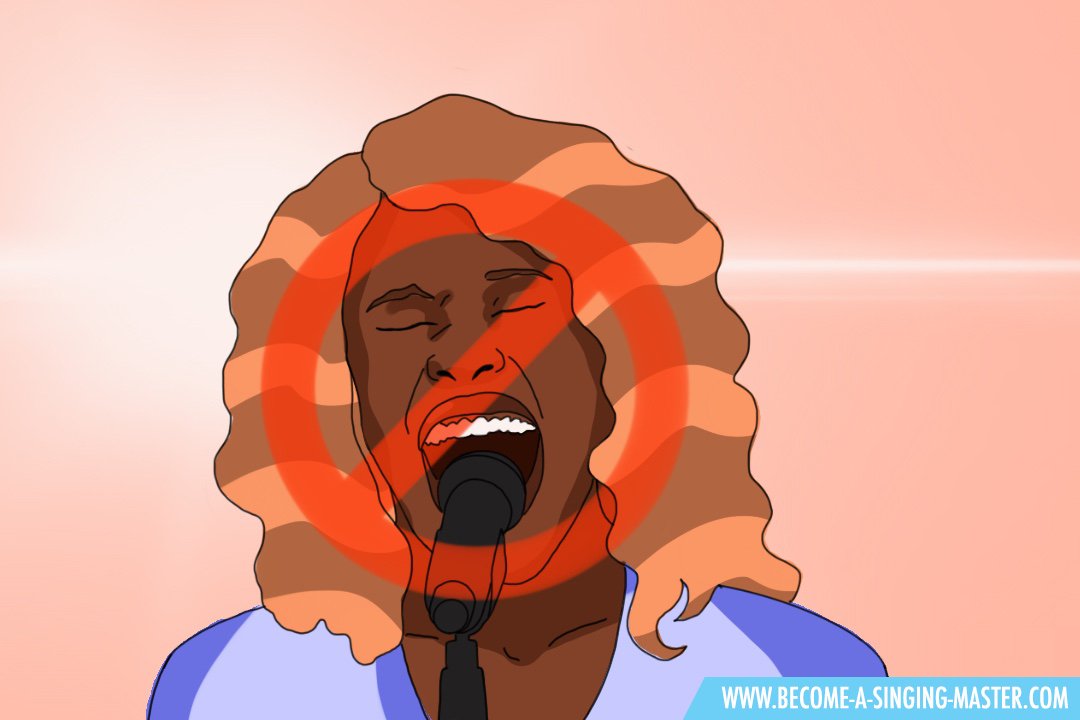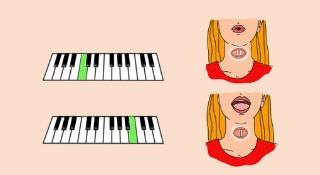6 Vocal Warm Ups The Pros Use
Vocal warm ups are so important for singing successfully.
Just as you would warm up before exercising any other part of your body the voice is no exception. It’s crucial if you want to perform to your best possible ability as a singer.
In this video I’m going to be giving you the exercises I personally use to warm up. This is something that has taken me years to build up to and has changed as my voice has progressed.
These warm ups will work whether you're a complete beginner getting ready for your first practice, or a world class superstar getting ready to entertain a stadium audience.
The Secret To Star Singing
Click HERE For The Secret To Star Singing
The Secret To Star Singing
Click HERE For The Secret To Star Singing
Why Do We Warm Up?

Typically when you wake up in the morning you may find your voice is a little groggy or hoarse. It may even take you a while to reach your “normal” way of speaking.
Running through these vocal warm ups will get everything moving nicely and make it much easier to sing.
Take Your Time
We all have sticking points and areas we find more difficult to warm up than others.
If you find any of the vocal warm ups difficult take your time and make sure you do them correctly.
If you've picked up some bad habits over the years it may take a little time for these to change.
But don’t worry, keep at it and change will come.
Let's go now go through my best warm up exercises as well as the order I do them in.
Humming Exercise

I like to start with some gentle humming to get the vocal chords moving.
When doing the Humming exercise it's a good idea to place your thumb at the back of your jaw where it connects to the neck.
This way you will really be able to focus on the muscles in your throat as you sing. If you feel these muscles tighten, do your best to relax them.
You will most likely feel resistance as your pitch increases. This is due to your body wanting to “fight you” as you work against the habit of using the wrong muscles to sing.
When this happens, it means that you've started using the swallowing throat muscles to sing instead of the vocal chords.
I call this falling back in your throat and it's not the ideal way to sing.
A good way to fix this is to smile to stretch and tighten your facial muscles (see video example).
Obviously you're not always going to smile when you're singing!
However, if you have trouble with your swallowing muscles tightening, this smiling trick can help you to reverse this bad habit.
How To Start
In the beginning you may not be able to maintain the correct pitch or note that you're going for.
It’s important that if you feel you're not hitting the correct notes, the best thing to do is to find a area or range in your voice where it's easier.
When you're using vocal warm ups it's important not to over extend yourself.
Once you're voice is successfully warmed up, you'll find some of the trickier notes easier to hit in tune.
Here's a demonstration of the Humming vocal warm up.
(The video below will automatically begins at 01:34 when the Humming demonstration begins)
And here's a audio file you can use to practice.
After practicing the Humming Exercise for 5-10 minutes lets move onto the next Exercise.
Nay Nay Nay Exercise
This is a great vocal warm up if you find your throat locking or tightening when you sing. The purpose is to move through these notes without falling back into your throat. This is slightly harder than the humming exercise.
It’s important that when you're using this exercise you make sure you don’t breathe out too much on the notes themselves.
This can cause you to get stuck in a particular tone which can make singing difficult.
Also, remember to keep you thumb under your chin.
Doing this allows you to create a great mental picture of how your vocal cords are working. And once again, it gives you great awareness for when you are engaging your swallowing muscles - which we don't want to be doing.
Here's a demonstration of the Nay Nay Nay vocal warm up.
(The video below will automatically begins at 02:48 when the Nay Nay Nay demonstration begins)
Here is a scale you can use to practice the Nay Nay Nay exercise.
Once you've done 5-10 minutes of the Nay Nay Nay exercise you'll notice your voice will be sounding more present.
Your sound will be sitting in a good, forward position in your mask.
And you will find yourself in a much clearer and free place with your voice. You’ll also be very aware of the muscles in your throat and really know if you begin falling back in your throat.
This is a good time to move onto the next vocal warm up exercise...
Lip Trill
You’re now ready for a slightly more complex warm up exercise. This is the Lip Trill. It’s great to warm up the lips and diagram before you sing.
To do this gently close your lips and blow out air through them. Your lips will vibrate naturally and easily to create a “brrrrrrr” sound.
Here's a demonstration of the Lip Trill vocal warm up.
(The video below will automatically begins at 04:23 when the Lip Trill demonstration begins)
And here is a scale you can use to practice the Lip Trill.
There are some important things to remember while warming up with the Lip Trill.
Such as...
Thinking Down
For this vocal warm up a very good mental exercise to use is to "think" that you're singing down when you're actually singing up your range.
It sounds strange, but what this does is keeps your diaphragm expanded and not tight and stiff.
It’s easier to direct your vocal chords this way and not lose your air.
Control Your Breathing
With this particular vocal warm up it is a good idea to not breathe in too deeply on the first note. This can cause your sound to get stuck in the back of your throat.
Finally, as you're doing the Lip Roll, remember to keep your thumb under your jaw so you can stay aware of your swallowing throat muscles tightening.
After 5-10 minutes of the Lip Roll exercise, let's move onto the next vocal warm up.
Tongue Trill

This is a more complex exercise. Typically if you can curl your tongue you should be able to do the tongue trill. This trill is done by rolling the tongue, typically in an "RRRR" sound, as well as alternating the note you create each time as we move up in pitch.
As with the other exercises, it's good practice to put your thumb under your jaw to have awareness of your swallowing muscles tightening.
If you are unable to do this properly you can instead use any sound you choose (a vowel sound for example) and sing the scales without vibrating your tongue.
Due to a greater complexity of this exercise I encourage you to go through the previous exercises first (especially humming) before attempting this one. This will allow you to execute this exercise to the best of you ability.
Here's a demonstration of the Tongue Trill vocal warm up.
(The video below will automatically begins at 05:06 when the Tongue Trill demonstration begins)
And here is a scale you can sing along to and warm up with the Tongue Trill.
Interval Changing Exercise
An interval means when you are moving from a lower note to a higher note with a gap in the notes. Or a higher note to a lower note.
In the previous vocal warm ups we have also been using intervals to practice with.
Here's a demonstration of the Interval vocal warm up.
(The video below will automatically begins at 06:06 when the Interval warm up demonstration begins)
And here is an audio file so you can practice along...
Don’t Strain
Often when doing these vocal warm ups we might be tempted to push or strain for a note.
You may be used to pushing for the notes due to habit. This can work in the short term work. However it can cause you to become locked (stuck in a note) when you get to the higher pitches.
With the tongue trill exercise you want to go to the highest note you can without pushing or straining.
As you rise through each interval try to flex the cheeks and bring them higher each time. This will allow you to have far more control of your note. (Watch the video above for a demonstration of this)
In the video pay attention to how this “closeness” increases on my face as I go up through the notes.
Doing this really helps to fight your natural tendency to try to force those higher notes.
Vowel Sounds Exercises
Another great vocal warm up is to use two vowel sounds in combination.
This will allow you develop more freedom and flexibility with your voice.
This allows you to really practice your control of maintaining and going back to a note while singing.
Here's a demonstration of using two vowel sounds on a scale.
(The video below will automatically begins at 07:15 when the Interval warm up demonstration begins)
And here is the exercise audio for you to practice along with.
The key with doing this two Vowel sound vocal warm up correctly is to try to keep your sound positioned in the same place as you switch from one Vowel to the next.
If you feel your sound shift as you change from one Vowel to another it means you are at risk of having your sound fall back into your throat or go too wide.
(More on this in a few minutes)
Descending Exercises
So far I've demonstrated all of the vocal warm ups on Ascending scales (where the notes are progressively getting higher).
It's also important to practice the exercises on using Descending scales. This will also help you sing nicely in your lower vocal range.
Let me demonstrate using a Descending scale in my lower range.
(The video below will automatically begins at 08:00 when the Descending scale demonstration begins)
If you've been using the Warm Up Scales I've been providing on this page you'll notice that all of these scales transition into a Descending version halfway through.
So just follow along until the end and the Descending scale will be built into your warm up.
Winning At Warming Up
Practicing these vocal warm ups will really allow you to expand your capabilities as a singer. Try to warm up before every singing session.
It may feel difficult at first. However, after a few short weeks this will become a natural part of your practice. Stick with it and you’ll be amazed how warming up will give you greater control and awareness of your voice.
3 Vocal Warm Ups That Make A Great Daily Routine
In this video I'll go a little bit deeper into 3 of the vocal warm ups we've just covered.
The Humming Exercise, the Nay Nay Nay Exercise and the Tongue Trill.
These three exercises will make up a great essential daily vocal warm up.
For a more extensive warm up you would do more than 3 exercises. However, we all lead busy lives. When building a new habit first we need to build up consistency. It needs to be something we can do every day. Even when we are tired or perhaps aren’t feeling are best.
So it's a great idea to start with just 3 exercises so you have time to do them daily. If you do these everyday your voice will transform and improve drastically even in a short space of time.
Some Final Points About Warming Up Effectively
Remember that these exercises are not built to look attractive!
When doing these exercises you may think to yourself that you look and sound silly.
They require you to make some strange looking faces and noises! But they are constructed to make you a better singer.
Don’t worry, as singers we all have to do it and we all look fairly ridiculous.
Trust in these exercises and they will bring you into a great place as a singer. Then when you go in front of an audience with a beautifully warmed up voice you will look anything but silly.
The Voice Guitar
A great visualisation technique for all of these warm up exercises (and singing in general) is this...
As you get higher in your range start to imagine your voice is getting really tiny. Think of it like the strings of a guitar. The thicker bigger strings create a lower pitch and the thinner smaller strings create a higher pitch. And as you fret the strings, they get shorter and create a higher pitch still.
Give it a go, it really helps.
Bad Practice

When you feel your swallowing muscles coming down as you practice and you can't seem to relax them, it's best to stop the exercise. If you keep going it can reinforce bad technique, which can then turn into a bad habit.
You'll often find that it will happen in a trickier part of your range. So if this is the case, stop and bring your voice back into a more comfortable part of your range.
Roll The R’s
This trill is done by rolling the tongue, typically in an r sound, as well as alternating the note you create each time as we move up in pitch. If you are unable to do this properly just use a different sound instead, as it will have a similar effect.
Remember to exaggerate your facial muscles and sound to really get a feel for this exercise. Think down and don’t try to push the notes. If you can’t curl your tongue you might not be able to do the tongue trill.
Alternate Exercise
If you are not able to do the tongue trill, instead use an alternate vowel sound and follow the same process. Remember you don’t want to feel the swallowing muscles going down.
Exaggerating the sound really helps to get you to sing from your facial mask .This is the best area to sing from, roughly around your mouth and nose.
Building A Daily Routine
If you are able to do these exercises every day correctly you will be on your way to developing a great voice. This can’t be achieved overnight.
It's important to continually retrain your body to stay in the right place.
I know this was something I had to do at the start of my singing career. It has really helped my singing even to this day.
It’s important to do these three exercises every single day. You don’t even have to spend that much time doing them. Just spend a few minutes. You really will notice the results in no time at all.
Your Voice Will Be Amazing
I hope these vocal warm ups benefit you and your singing for warming up. Remember the voice needs to be trained every day. This way you’ll keep improving as a vocalist.
The difference between a good and a great singer is how consistent they are with their practice as well as the quality of their practice.
So do a little bit each day and you'll be well on your way. I hope this resource will help you develop an effective vocal warm up routine.
One that will help you optimize your voice for your performances as well as continually improve your technique.
If you have any questions or comments, please leave them below!
About The Author
 Roger Burnley - Vocal Coach Roger Burnley - Vocal Coach |
Roger Burnley is a vocal coach located in Hollywood, California. He has been teaching singers for over 30 years and singing for even longer than that.
Notable past and present clients include Macy Gray, Brandy, Ray J, The Beastie Boys, James Torme, Taylor Lautner, Nona Gaye, and many more.
His clients have collectively sold more than 30 million albums, with several reaching Platinum and Gold status.
Roger has been featured on VH1, TV Guide Channel, TV One,
and MTV appearing as a vocal expert.
About The Author
 Roger Burnley - Vocal Coach Roger Burnley - Vocal Coach |
Roger Burnley is a vocal coach located in Hollywood, California. He has been teaching singers for over 30 years and singing for even longer than that.
Notable past and present clients include Macy Gray, Brandy, Ray J, The Beastie Boys, James Torme, Taylor Lautner, Nona Gaye, and many more.
His clients have collectively sold more than 30 million albums, with several reaching Platinum and Gold status.
Roger has been featured on VH1, TV Guide Channel, TV One,
and MTV appearing as a vocal expert.























New! Comments
Show me you're alive! Leave a comment below...